2018 Yamaha Kodiak 450 Review
Riding Yamaha's modern midsize machine
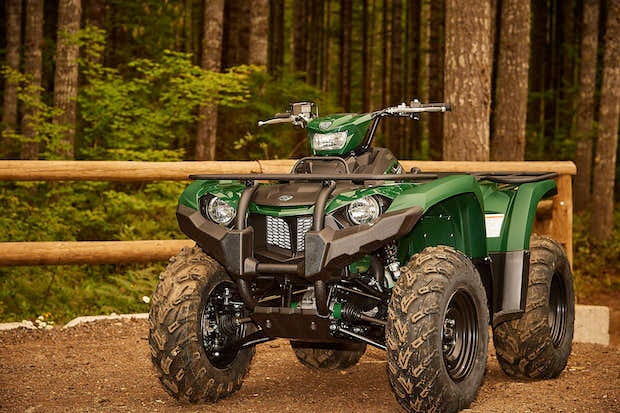
In a market that is still in a race to the top of the power charts, Yamaha hasn't forgotten about its entry-level offering, and for 2018, the all-new Kodiak is getting the Japanese brand back into the midsize ATV segment.
The new Kodiak 450 replaces both the Grizzly 450 and old Kodiak 450 in Yamaha's lineup and gets the brand back in the midsize ATV market with a thoroughly modern machine. Updating its small machine's technology was certainly a priority for Yamaha, but an all-new chassis has also been devised which gives the Kodiak 450 what is likely its biggest advantage in this segment. But before we talk about that, let's hit the basics.
Rig Rundown
The modernizing of its midsize model starts with the engine, moving away from a carburetor to a new direct-injection 421cc liquid-cooled engine, which runs a 10.0:1 compression ratio. New rubber engine mounts have been added to reduce vibration, while the clutch sensitivity has been changed to also smooth out the ride.
Many of Yamaha's mainstay technologies haven't changed, but that's because they didn't need to. The independent double wishbone suspension remains along with the selectable two- or four-wheel drive, controlled by a button on the handlebar. Suspension travel has been slightly improved, up to 6.7-inches in the front and 7.4-inches in the rear end, while five-way adjustable shocks are still used. Ground clearance stands at 9.6 inches.
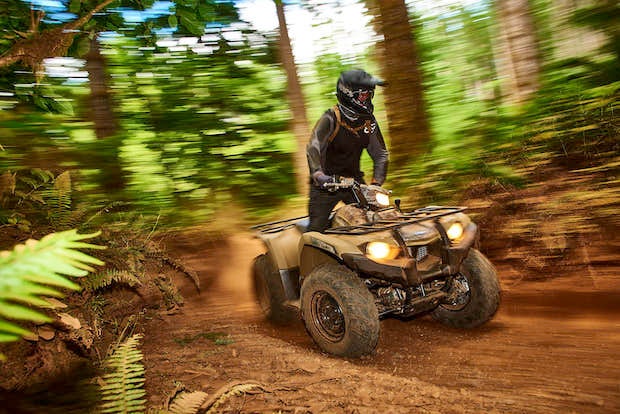
The real key to the new Kodiak 450 though has to do with its size. Total length measures 80.1 inches, width comes in at 46.5 inches, wheelbase measures 48.8 inches and full height sits at 45.7 inches. In comparison, this Kodiak is about two inches shorter than its nearest competitor, the Honda Rancher 420, and about an inch narrower.
But stretching of the rider's footwells, re-positioning of the shifter and a new skinny seat allow for the Kodiak to accommodate larger riders comfortably, something the Rancher doesn't quite do.
Having recently been on a Rancher 420, Honda's midsize ATV comes across feeling small, and had I not read the numbers, I would have bet the Rancher was the more compact machine. And that's the strongest point that can be made about the new Kodiak.
The Kodiak 450's small footprint has been combined with a large feeling rider environment, allowing the machine to be small but feel big, an excellent combination when you hit the trails, especially tight stuff like we were riding in the Pacific Northwest in the Capitol State Forest.
The Ride
Picking our way through the tight trails of the almost pre-historic feeling forests of Washington State, the agreeable size of the Kodiak 450 was demonstrated over and over again. The ATV feels nimble and thanks to the new skinny seat and generous space for the rider's legs and feet, standing up and using your body weight to help guide the Kodiak 450 is simple. It seems to be a larger machine when you sit on it thanks to the design, but scraping fenders creeping through massive trees is when the small size of the Kodiak comes in handy.
Standing at 6' 2" it is clear that I am one of the big guys Yamaha was plotting to appease when it first designed the proportions of the Kodiak 450, and the sizing here feels just right. Slightly taller handlebars on this machine allow me to stand up nearly straight while remaining in solid contact with all of the necessary controls, while those longer running boards let me position my feet in different spots for different situations depending on where I needed to move my body weight. An all-new larger thumb throttle also offers more variety in where you can position your hand on the bar, further allowing you to move around.
All the comfort baked into the Kodiak's size would mean nothing without a ride to back it up, and the Kodiak delivers that as well.
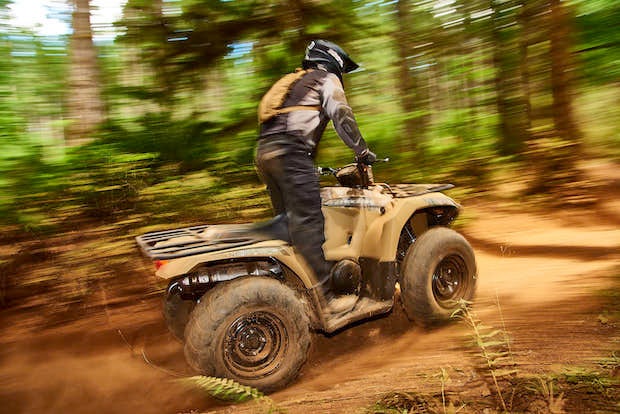
The independent suspension provides an entirely comfortable ride and offers few compromises compared to Yamaha's bigger machines. Of course being able to adjust the pre-load on the suspension means that each rider can dial in what works best for them, and riding in the factory-set second position, the Kodiak felt soft and comfortable but certainly not to the point of wallowing around the trail.
Yamaha doesn't go crazy with power steering boost either, nailing the balance. The trail's imperfections are clearly communicated through the steering, but when a nasty stump or rock nails your front wheel unexpectedly, the power steering does just enough to keep the bars from being ripped away.
As for power, the 450 provides plenty. Off the line, it is not the punchy torque hit you'd get from a big bore, but rather a gradual push into the power, allowing the machine to feel controllable thanks to its linear power delivery. This instant hit of torque down low may be one of the downsides of using a CVT, but as the rpm climb so does the power coming from the 450. Running on wide open trails, the Kodiak didn't feel lacking at all with tons of top-end power, though if we were putting it to work with a trailer out back, a little more low-end torque would be appreciated.
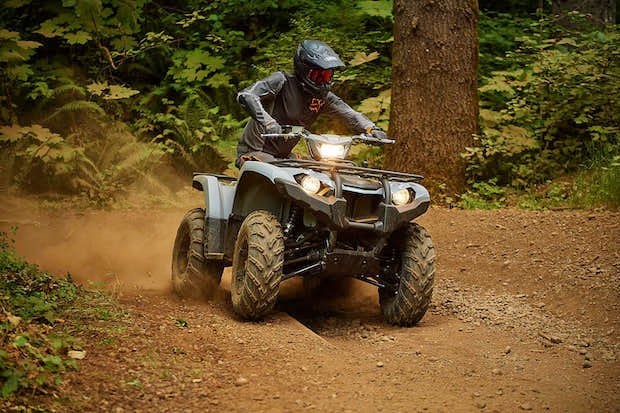
Yamaha says that the Kodiak's cargo racks can handle 264 lbs combined while its tow rating is set at 1,322 lbs, enough to pull most personal watercrafts, small boats and a wide array of utility trailers.
A big part of this equation is Yamaha's Ultramatic transmission, which applies constant belt tension. On the trail this results in that smooth engine take off and also allows for all-wheel engine braking when you back off the throttle, never allowing the ATV to begin free-wheeling down hills. Setting the transmission in Low coming downhill, the engine braking is powerful, allowing the rider to focus on the line and forget about the brakes.
There's even a multi-use info screen included on all Kodiak models, offering speed, a digital fuel gauge, a trip meter and an all-new service interval meter which will turn on the service light at the set pre-set distance to remind you to take care of your Kodiak.
After a day of riding, it's clear that Yamaha wanted as few compromises as possible when stepping down into one of its smaller machines and with the Kodiak, there are few if any conveniences sacrificed compared to the brand's bigger machines.
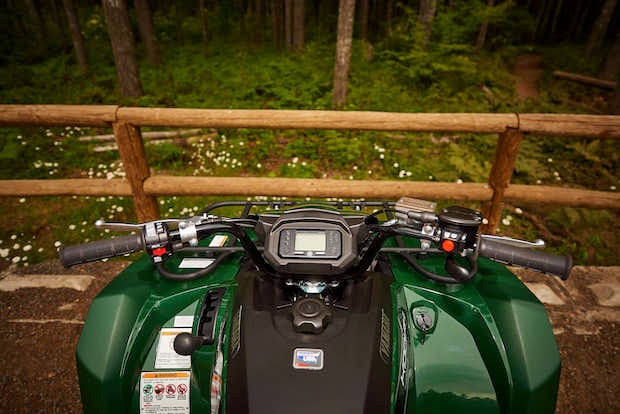
If we had one other criticism it would be the lack of storage on this Kodiak, and that mostly stems from our love of the storage box on the Grizzly 700 located right in front of the rider. The Kodiak does offer under seat storage, but it would be great to have a spot at hand to stash your odds and ends.
Pricing
Pricing is a big part of the Kodiak equation and it truly is entry level. Going for the base model without electric power steering, you will spend $5,999, while opting for the Fall Beige model with a camouflage graphic on it brings the cost up to $6,249.
Bump up to an EPS model and you'll spend $7,099 for an Armor Grey model with aluminum wheels or just $6,899 for a base EPS model without the special wheels. Again, the Fall Beige with the graphics goes for the most, selling at $7,149.
That puts the Kodiak pretty well in line with its main competition from Honda, the Rancher 420, which sells for $5,349 at the bottom. Load up a Honda model to its top trim and it ends up being more expensive than the Yamaha, selling for $8,099.
The Verdict
Yamaha has come back to the midsize ATV table with a modern machine that offers big comfort with a small footprint at an affordable price. It's a deadly combination in a marketplace looking to do away with compromise, and the Kodiak 450 has plenty to offer to first-time buyers and seasoned ATV veterans alike.


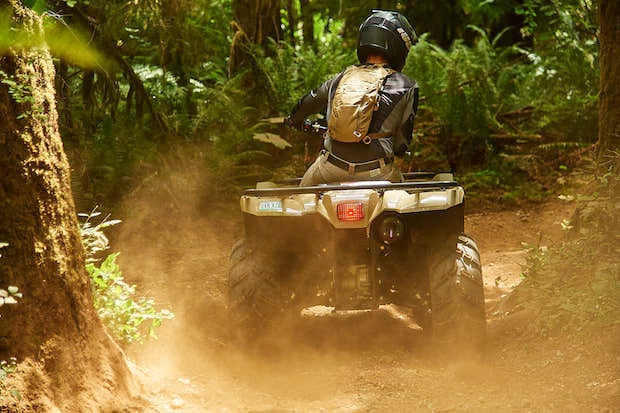

 Your Privacy Choices
Your Privacy Choices